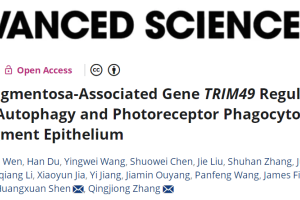

The retina is a highly specialized sensorineural tissue composed of diverse cell types, each with distinct functional roles in vision. Among these, the rod and cone photoreceptors are unique in their possession of large specialized sensory cilia, which are essential for phototransduction, while nonphotoreceptor neurons typically exhibit simpler primary cilia. Mutations in ciliary genes result in multiple retinal diseases, such as retinitis pigmentosa (RP), cone–rod dystrophy (CORD), Leber congenital amaurosis (LCA), and Bardet–Biedl syndrome (BBS). However, most current research has focused on ciliary regulation in photoreceptors, with limited understanding of ciliogenesis in non-photoreceptor neurons.
On July 15, the research team led by Prof. Mengqing Xiang at Zhongshan Ophthalmic Center of Sun Yat-sen University published a study titled "Foxn3 is required to suppress aberrant ciliogenesis in nonphotoreceptor retinal neurons" in PNAS. The study identifies Foxn3 as a key transcriptional repressor in retinal ciliogenesis. Retina-specific knockout of Foxn3 leads to ectopic expression of ciliary genes and aberrant cilia formation in non-photoreceptor neurons, resulting in visual dysfunction. These findings provide potential new therapeutic targets for retinal ciliopathies.
Research Findings
In this study, the research team first generated retina-specific Foxn3 knockout mice (Foxn3CKO), then systematically analyzed changes in retinal structure, optic nerve, and visual function at different developmental stages in Foxn3CKO mice. The results showed no alterations in retinal structure or optic nerve in Foxn3CKO mice. However, electroretinogram (ERG) test revealed significant changes in the scotopic b-wave and oscillatory potentials (OPs). No significant differences were found in the scotopic a-wave or photopic responses (Figure 1). Further studies have shown that the specification and differentiation processes of retinal development are largely unaffected by the absence of Foxn3 (data not shown), suggesting that the primary role of Foxn3 is in regulating other retinal phototransduction structures rather than cell fate determination and differentiation.

Figure 1: Decreased scotopic ERG responses of Foxn3CKO mice.
To explore the molecular basis of the visual defect caused by Foxn3 ablation, the team carried out scRNA-seq analysis of adult control and Foxn3CKO retinas. The results demonstrated that non-photoreceptor neurons in Foxn3CKO retinas exhibited aberrant activation of numerous cilia-related genes. The study revealed that these ciliary genes—normally expressed specifically in photoreceptor cells—were significantly upregulated in bipolar and amacrine cells. This phenomenon is analogous to erroneously equipping signal-transducing neurons with photoreceptor-specific "signal receivers" (Figure 2). This "mislocalization of ciliary genes" may lead to abnormal visual signal transduction.

Figure 2: Changes in single-cell transcriptome profiles between control and Foxn3CKO retinas.
Further experiments demonstrated that Foxn3 knockout caused dramatic upregulation of ciliary genes such as Armc2, Dnah5 in bipolar and amacrine cells, by 2- to 100-fold compared to control retinas. Moreover, numerous ectopic cilia appeared in the inner nuclear layer (INL) of Foxn3CKO retinas, with a 77-fold increase in cilia of bipolar cells and a doubling in cilia of amacrine cells. These ectopic cilia were co-localized with the bipolar and amacrine cell markers (Figure 3), confirming that Foxn3 deficiency not only causes aberrant ciliary gene expression but also leads to pathological ciliogenesis in non-photoreceptor neurons.

Figure 3: Upregulation of ciliary gene expression in Foxn3CKO retinas.
To uncover the gene regulatory network by which Foxn3 controls retinal ciliogenesis, the team conducted ChIP, CUT&Tag, and luciferase assays (data not shown) to demonstrate that Foxn3 maintains the dichotomy of ciliary differentiation in retinal cells by acting as a transcriptional repressor of ciliary genes. The Rfx family of ciliary gene transactivators, in particular Rfx3 and Rfx7, may promote the differentiation and formation of the photoreceptor sensory cilia. In late postnatal and adult retinas, Foxn3 is specifically expressed in nonphotoreceptor neurons, and inhibits cilia formation through a dual mechanism: it directly inhibits ciliary gene expression, and indirectly blocks the cilia formation pathway by repressing the Rfx and Foxj1 genes. The Foxn3 and Rfx transcription factors may also precisely balance the expression levels of ciliary genes through their own autoregulatory mechanisms, ensuring the formation of complex sensory cilia in photoreceptor cells while preventing nonphotoreceptor neurons from generating abnormal ciliary structures.

Figure 4: Working model of how Foxn3 may regulate retinal ciliogenesis.
Link to Original Article:
https://www.pnas.org/doi/10.1073/pnas.2500871122
Firstauthor and correspondingauthor affiliation: Zhongshan Ophthalmic Center of Sun Yat-sen University. Prof. Mengqing Xiang and Associate Researcher Dongchang Xiao are the co-corresponding authors of this paper, Associate Researcher Shuting Liu and Master’s student Junyao Chen are the co-first authors of this paper. This work was supported by the “Technology Innovation 2030-Major Projects” on Brain Science and Brain-Like Computing of the Ministry of Science and Technology of China, National Natural Science Foundation of China, Science and Technology Planning Project of Guangdong Province, Science and Technology Program of Guangzhou, and the Fundamental Research Funds of the State Key Laboratory of Ophthalmology, Sun Yat-sen University.











